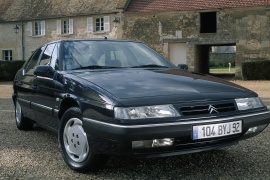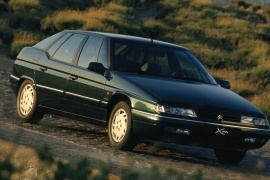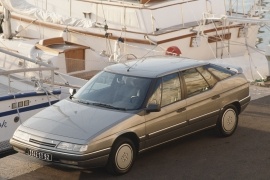CITROEN XM Models/Series Timeline, Specifications & Photos
First production year: 1989
Engines: Gasoline, Diesel
Body style: Hatchback
It was the last stint for the oldest model in Citroen's lineup. The company's management didn't consider enhancing the aesthetic part of the car and bringing it to those time standards. It was left to die on the market.
After Peugeot took over Citroen's shares, the new owner started to change the company's image and also made it more affordable. Perhaps it was the best way to save the famous brand that once sold more cars in a day than anyone else (the DS). Moreover, Peugeot had to decide whether to keep the brand as a premium carmaker or drag it into the same pool as Renault and Opel. It chose the latter.
When Bertone Studios penned the car, it made it almost timeless. Still, by the late '90s, the biodesign era imposed waved lines and curved panels. In contrast, the XM was nowhere near with its flat surfaces and angular styling. Curiously, though, it didn't look exactly outplaced. Unfortunately, PSA's management considered it wasn't worth investing in new body panels or bumpers. Hence, it left it like it was after the 1994 facelift.
Inside, the designers faced the same dilemma: to refresh it or not. The short answer was no. They didn't rework the cabin, but there were a few more standard features, such as the air-conditioning. It was an excellent addition but not enough to conquer the customers' hearts and wallets.
Under the hood, the most significant upgrade was the addition of the three-liter, 24-valves V6 powerplant. It developed 194 hp (197 PS) and was mated, as an option, to a newly introduced adaptive automatic gearbox. It was quite an improvement but, again, not enough. Last but not least, the turbodiesel versions were limited to just two options, and both sent their power via a five-speed manual.
When Citroen introduced the XM in 1989, it won the European Car of the Year award for its styling and many innovations brought along, but it needed a refresh five years later.
Designed by Bertone and technologically advanced, the XM was, perhaps, the first production vehicle with an adaptive suspension. Its qualities were beyond any other French car and over many other vehicles on the market. In terms of comfort and visibility, it could outrank most of the cars, except the convertibles. But that wasn't enough to keep the big Citroen running and introduced a facelift in 1994.
While it was easy to refresh a badly designed car, it was tough to improve a vehicle designed properly right from the start, as it was the XM. Its wedged-shape didn't look out of place at the beginning of the bio-design era with flowing lines. It looked different but in a good way. There was a new front bumper that lost the wide parking and fog lights. The car sported now an apron under the bumper, which diverted the air on the sides of the car. Its grille was still narrow, but it wore a slimmer horizontal slat. In the back, Citroen replaced the formerly used wing with a lip on the tailgate and kept the same value for the aerodynamic factor.
The most significant change was inside the car, where a completely new dashboard with rounded shapes replaced the wedged-shaped one used before. Citroen lost its traditional one-spoke steering wheel, which now sported four spokes and an airbag.
Citroen introduced new or improved engines to match the car's weight and dynamic look. For specific versions, it included a four-speed automatic transmission, which significantly improved the driver's comfort.
Citroen finally replaced the aging CX lineup in 1989 and approached a completely new design language, carried over from the successful BX range, and also reversed the letters in the nameplate, thus resulting in the XM.
While the CX was developed during its independence years, the XM was conceived under Peugeot's ownership. This was reflected in many aspects, and purists are not very convinced by the results. Moreover, the vehicle's quality was no longer at the same level as before. Yet, the car sold well thanks to its prestige and unique features, such as the hydropneumatic self-leveling suspension.
With its angular shape and narrow headlights, the XM proved that sharpness might be aerodynamic. It didn't need the same curved panels and air-sculptured lines on the bodywork to cut through the air like a hot knife through butter. A sculptured line crossed the car from front to back and helped the Bertone design team to neatly integrate the door handles. Yet, due to cost-cutting reasons, these were black, although they should have to match the car's color. Moreover, there was no option to have them painted. In addition, Peugeot decided that the car had to have a liftback shape and a tailgate in the rear, unlike the CX, which featured a separate trunk lid.
Inside, the angular shapes were kept. Even the steering wheel had a squared center instead of round, like anyone else. Moreover, depending on the trim level, the XM sported buttons on the steering wheel, which was an unusual feature for a 1989 car. The comfortable seats were available with either velour upholstery or leather.
Under the hood, Citroen offered a choice of three gasoline and two diesel engines. The carmaker paired them with either a five-speed manual or an automatic gearbox.


